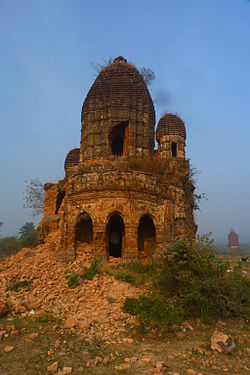Garh Panchkot
| Garh Panchkot | |
|---|---|
| city | |
 |
|
| Location in West Bengal, India | |
| Coordinates: 23°36′00″N 86°46′00″E / 23.6°N 86.76667°ECoordinates: 23°36′00″N 86°46′00″E / 23.6°N 86.76667°E | |
| Country |
|
| State | West Bengal |
| District | Purulia |
| Languages | |
| • Official | Bengali, English |
| Time zone | IST (UTC+5:30) |
Garh Panchkot is a ruined fort located in the eastern part of India at the foot hills of Panchet Hill in the district of Purulia, West Bengal, the ruins of the Panchkot Palace are a silent testimony to the Bargi attack during the 18th century.
From a historical perspective Alivardi Khan had become the Nawab of Bengal in April 1740, having defeated and killed Sarfiraz Khan. Rustam Jung, Sarfiraz's brother-in-law challenged Alivardi Khan but failed in his endeavours which prompted him to sought the help of the Maratha Rulers of Nagpur, Raghoji Bhonsle. A Maratha cavalry was sent by Bhosle who entered Bengal through Panchet and started looting the countryside. These Maratha men came to be known as "Bargi's". For about 10 years they looted and plundered Bengal. It ended in the year 1751 after a settlement was reached between the Nawab of Bengal and Maratha King. During one of these encounters Garh Panckot was attacked by the "Bargi" and having defeated the King's guards they destroyed it after looting and plundering the palace. It is believed that all the 17 wives of the king committed suicide in a nearby well during the attack. Garh Panchkot has lain in ruin ever since.
In the fort's construction a combination of natural and man made resources were used to build it.
A semicircular moat was built which started from one end of the foothill to the other end. The only way to enter was by crossing the moat by using a boat at the centre of the semicircle. The rest of the area was either inaccessible due to large growth of a special type of bamboo tree which grew thick wild making it very difficult for intruders as well as a thick and high stone wall that was constructed.
600 feet above in the middle of the Panchakot Hill were the guard's quarters. In contrast to the architecture of the palace below, it was completely made of large stone slabs.
The guard's quarter has a strategic position. Spread over a 500 square meters area is more of a miniature fort surrounded by solid rock walls with only one entry point, the pyramid like hollow gate from where the entire palace below and the surroundings could be watched.
Once inside the fort, on the right as well as left there are two long and narrow rooms with small vents overlooking the plains. In the centre stands a stone temple dedicated to Rama the king of ayodhya, this signifies that it was truly a guards quarter as more appropriately the people who guarded the area were the elite warriors and generally worshiped Rama as he represented strength, courage and who had fought many wars. From the other remains one can't ascertain the true nature of its usefulness; a hollow lions head made of stone known as the "Singh Mukh" or other artefacts mostly made of stone.
...
Wikipedia

